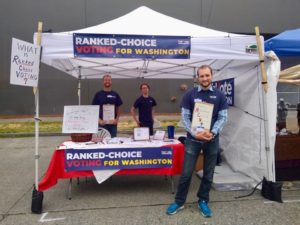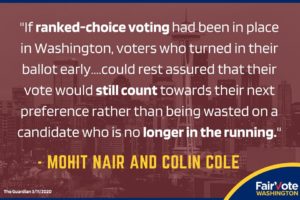
The timing of the COVID-19 pandemic, particularly in our electoral calendar, seems almost sinisterly planned. Yet, while we hunker down in our homes, in Fremont or wherever you’ve landed for the duration of the Governor’s ‘Stay Home, Stay Healthy’ directive, it does give us time to educate ourselves to be better voters, in preparation for Fall elections.
If that is too ambitious, maybe what you can manage is just to familiarize yourself with Ranked Choice Voting, and the work of FairVote Washington. Mohit Nair, a new Fremonster, is working with this non-partisan, non-profit organization as their Partnerships Director. Even in virtual lockdown, Nair is attempting to reach voters (and potential voters) to recruit neighbors in his efforts to spread the word about this more civil, less divisive approach to electing our leaders.
Using Zoom, FairVote Washington is offering on-line 101 classes in Ranked Choice Voting (RCV), and other skills for supporters (like writing Letters To The Editor,) and potential supporters. Once everyone gets back out and circulating, Nair and FairVote Director Lisa Ayrault will be able to go out and talk to groups (and our legislators,) but now is an ideal time for Fremonsters to learn about the benefits of RCV – and to share the message with friends on social media.

Ranked Choice Voting, A (Very) Primer
“Ranked Choice Voting is a simple change to the way we vote,” Ayrault explained, “it’s all about giving an option to voters, who can still vote for one candidate. It can make your voice more powerful.”
Very simply, with ranked choice voting, voters number the candidates on their ballots in their order of preference. For instance, in a crowded primary race, it would be possible to vote:
- First and Favorite Candidate
- The Ok, I Guess Choice
- Better-Than-Nothing
- If We Have To
- Seriously, There’s No One Else?
With RCV, voters prioritize their choices – or vote for a single, ideal candidate. Ultimately, RCV could do away with (expensive) primaries, and allow voters to choose from among many candidates instead of the two majority, best-funded, establishmentarian choices.
Developed over 100 years ago by an American, RCV has already been adopted by Australia, New Zealand and Malta. The methodology has also been put into voting in the state of Maine, as well as in cities and counties throughout the U.S.

Strike While The Time Is…
Talk of Ranked Choice Voting is particularly timely given the results in the recent Washington State Democratic Party Primary. Early, mail-in voting is a beneficial, efficient method, less susceptible to hackers, but many local voters felt burned last March when their votes were left uncounted after their candidate dropped out of the race. Ayrault reported that “almost 400,000 voters voted for candidates that were not viable.”
Nair observed that it was nearly 25% of voters whose ballots were essentially wasted due to our traditional voting system. “You only got to pick one,” Ayrault said. Under RCV, these voters could have cast votes for as many candidates as they wished. If their first, second and even third choice had stepped aside, their fourth, fifth or even sixth choice might meant another candidate getting leveraged into position, or not, but it would have given a clearer ‘winner.’

More Civility? Reduced Polarization?
With the traditional voting system, candidates have been incentivized to engage in negative campaign tactics. As a zero-sum game, elections usually come down to a choice between two major candidates, who benefit from attacking each other. Ranked choice voting can shift focus from denigrating your opponent to reaching out to attract a broader subset of the electorate – and not alienating the other candidates’ supporters, in order to become their second or third choice.
Basically, if candidate Joe Jones knows that if he sweet talks candidate Joan Smith, and her supporters, they may vote for him second. If he’s got a brain in his head, Jones won’t mud-sling at Smith for fear of alienating her, and losing her supporters. For Smith can draw the first place votes from her supporters, but Jones can get first place votes from his own base and the second place votes from Smith’s supporters. With all of those, Jones can rocket past the other candidate – perhaps one at the polar opposite end of the political spectrum.

“As a voter, you will feel pressure to vote for the lesser of the two evils,” Ayrault said, “We’re so used to doing this.” Under RCV, voters can vote for as many, or as few, of the candidates as they like – and vote their convictions.
For traditional voting can create an election result that doesn’t reflect the will of the majority, and winners gaining by getting the most votes, but not a majority. Vote splitting and wasted votes often occur. Voters may want an independent, third party, new thinking candidate, who reflects their political convictions, but have to settle for the one who can ‘win’ – think Ross Perot, Ralph Nader or Bernie Sanders.
Studies have shown that ranked choice voting has actually encouraged candidates from more diverse backgrounds to run for office. To avoid vote splitting, and wasted votes, strong, well-funded, politically ‘safe’ candidates are encouraged, and first-time, young, female and/or candidates of color get discouraged. The pushing of establishment candidates also disheartens the electorate, who get tired of voting for the same kind of candidate every time. “Voters can honestly vote for their first choice,” Ayrault explained, under RCV, “this could break up the ossification of the party system,” and reduce political polarization.
“Having more choices on your ballot is a great thing,” Nair said, “it’s about making the electoral process more engaging.”
More Diversity? Reduced Costs?
As ranked choice voting encourages more candidates, from more diverse views and backgrounds to run, it is possible that the money could spread around more equitably. A broader field of candidates can lower the importance of big money, and the opportunities for influence peddling, as candidates of conviction may enter the field and garner votes.
When San Francisco converted to using RCV they saw voter turnout increase approximately 2.7 times, and in its most racially and economically diverse neighborhoods, voter participation nearly quadrupled. RCV is intended to improve democracy by increasing opportunities for communities to elect candidates that reflect their values and perspectives.
One of the most compelling arguments for ranked choice voting is that it can save money for the jurisdictions by eliminating the need for multiple rounds of voting. Primaries could be eliminated, where feasible, as even a field of candidates 20 deep (think the 2017 Seattle Mayoral primary) can be decided as voters get to select their top three, or five, or 10 choices. The loss of multiple runoff elections also saves money as campaigns don’t have to spend and spend on advertising and outreach in front of each and every election.
Next Step Toward RCV
Washington State law currently prohibits Ranked Choice Voting, but that law can be overturned, and a state-wide ballot initiative run to choose RCV for our jurisdiction. Right now, even if Seattle voters wanted RCV, the state law requires a top two election. Under the Seattle City Charter, we can use RCV in primaries, but for General Elections, we must wait until the state law is overturned.
FairVote Washington has been working on a Local Options Bill in the State Legislature (House Bill #1722.) This would give jurisdictions in our state the option to use RCV. In the last legislative session, the Bill had 27 co-sponsors, and reached committee. “We made very good progress,” Ayrault observed. In January, FairVote hopes to bring back the Local Options Bill and get it entirely through the session – especially as voters learn more about this system and contact their representatives about supporting it.
“Let your legislators know,” Ayrault asked of those who want to see RCV become the way we vote. Twice a week, FairVote offers an on-line RCV 101 workshop, which allows for participants to ask questions and get clear answers. FairVote also offers classes in writing letters and doing advocacy.
According to Ayrault, the only real opposition to RCV is the status quo. “It’s easier to do things the way things are,” Ayrault has heard, but she knows there are many different ways to vote – and our traditional, plurality voting is only one of them. For Nair, it comes down to the voters and allowing them to, “vote for your honest first choice.”
Nair also encourages people to sign-up through the FairVote Washington website, to be a supporter. “It lets us count how many people support RCV when we go to Olympia,” Ayrault explained. Nair is available to speak about RCV to groups, maybe in the next month, on Zoom or at house parties. “We’re trying to build a broad spectrum of supporters,” he explained, “generational, racial, party, etc. No matter what issues you care about,” he offered, RCV can help those candidates.
For more information about RCV, visit the FairVote Washington website (click here,) and consider joining an on-line, 101 webinar this week!
Related Articles
- A Picnic-In-The-Park Manifesto To Come
- by Kirby Lindsay Laney, June 23, 2014
- A Pizza Picnic & District #6 Candidate Profiles
- by Kirby Lindsay Laney, June 9, 2015
- Long Live the Mayor of Fremont
- by Kirby Lindsay Laney, October 18, 2006 in the North Seattle Herald-Outlook
©2020 Kirby S. Laney. This column is protected by intellectual property laws, including U.S. copyright laws. Reproduction, adaptation or distribution without permission is prohibited.

